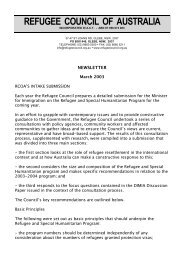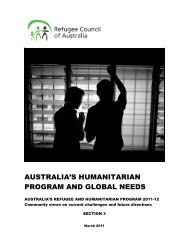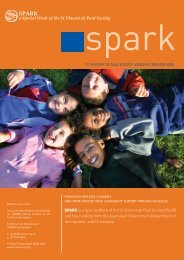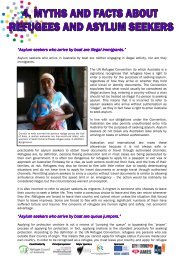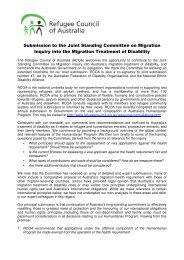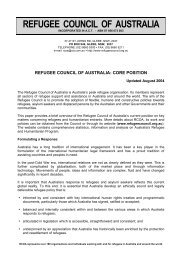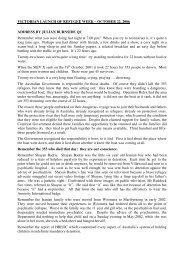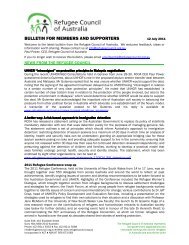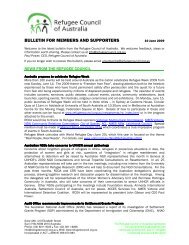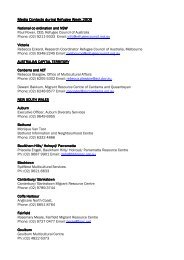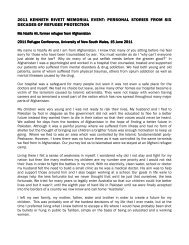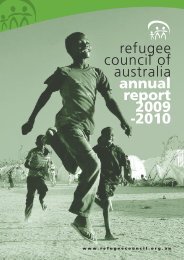The Institution of Bride Wealth - Australian Refugee Rights Alliance
The Institution of Bride Wealth - Australian Refugee Rights Alliance
The Institution of Bride Wealth - Australian Refugee Rights Alliance
Create successful ePaper yourself
Turn your PDF publications into a flip-book with our unique Google optimized e-Paper software.
Briefing Note on Southern Sudanese Women &<br />
the <strong>Institution</strong> <strong>of</strong> <strong>Bride</strong> <strong>Wealth</strong>: <strong>The</strong> Changing<br />
Nature <strong>of</strong> this Practice through Conflict,<br />
Displacement and Resettlement<br />
Sarah Shteir<br />
Comments Invited<br />
to crr@unsw.edu.au<br />
Available at:<br />
www.crr.unsw.edu.au<br />
CONTENT<br />
I. <strong>The</strong> <strong>Institution</strong> & Practice <strong>of</strong> <strong>Bride</strong> <strong>Wealth</strong> in Southern Sudan<br />
II. Impact <strong>of</strong> the Conflict on the Practice <strong>of</strong> <strong>Bride</strong> <strong>Wealth</strong> in Southern Sudan<br />
III. <strong>Bride</strong> <strong>Wealth</strong> Practices Among Sudanese <strong>Refugee</strong>s in <strong>Refugee</strong> Camps and<br />
Settlements: Focus on Uganda & Kenya<br />
IV. <strong>Bride</strong> <strong>Wealth</strong> Practices Among Resettled Sudanese <strong>Refugee</strong>s in Sydney, Australia<br />
V. Comparative Analysis <strong>of</strong> Market-Driven Resurgence <strong>of</strong> Dowry Practices in India<br />
VI. Addressing & Challenging the Continued Practice <strong>of</strong> <strong>Bride</strong> <strong>Wealth</strong><br />
VII. Sources<br />
BACKGROUND<br />
This briefing note is intended to provide an overview <strong>of</strong> the practice <strong>of</strong> bride wealth among<br />
Southern Sudanese communities in Sudan, and the changing nature <strong>of</strong> this practice due to the<br />
impact <strong>of</strong> conflict, the experience <strong>of</strong> displacement to refugee camps, and resettlement to<br />
countries such as Australia. This briefing note includes a comparative analysis <strong>of</strong> the marketdriven<br />
resurgence <strong>of</strong> dowry practices in India in order to draw attention to the economic<br />
influences on such a practice and the resulting monetisation <strong>of</strong> the practice and commodification<br />
<strong>of</strong> women involved.
Research on <strong>Bride</strong> <strong>Wealth</strong> Practices Among Sudanese Communities<br />
I. <strong>The</strong> <strong>Institution</strong> & Practice <strong>of</strong> ‘<strong>Bride</strong> <strong>Wealth</strong>’ in Southern Sudan<br />
To my mother, I am a beast <strong>of</strong> burden<br />
To my father, a source <strong>of</strong> income<br />
To my brothers and cousins, a servant<br />
To a sugar daddy, a fruit<br />
Who Cares?<br />
(A poem recited by teenage girls during a visit to Kakuma <strong>Refugee</strong> Camp by the UN High Commissioner for<br />
<strong>Refugee</strong>s António Guterres in 2005. 1 )<br />
Common among diverse ethnic groups <strong>of</strong> Southern Sudan is the institution <strong>of</strong> ‘bride wealth’ in<br />
marriage practices, which some also refer to as ‘dowry’ 2 . <strong>Bride</strong> wealth refers to a payment by the<br />
groom’s family to the family <strong>of</strong> the bride. <strong>The</strong> form <strong>of</strong> this payment varies among ethnic groups,<br />
depending on the groups’ customs and economy <strong>of</strong> the area among other determining factors.<br />
Among the Southern Sudanese, bride price is commonly associated with cattle, though it may<br />
also take the form <strong>of</strong> sheep, donkeys, goats, agricultural tools, weapons, beads, increasingly<br />
cash, or a combination <strong>of</strong> cash and other items.<br />
<strong>The</strong> practice <strong>of</strong> bride wealth is governed by the customary law systems <strong>of</strong> Southern Sudan. <strong>The</strong>re<br />
are multiple customary law systems across Southern Sudan as most <strong>of</strong> the fifty-plus tribes in the<br />
region have their own discrete body <strong>of</strong> customary law reflecting their own group identity. 3 <strong>The</strong>re<br />
are commonalities across these systems, however, such as the institution <strong>of</strong> bride wealth. In the<br />
context <strong>of</strong> Sudan, ‘customary law’ refers to the “body <strong>of</strong> traditions, mores, social conventions and<br />
rules that through long usage and widespread acceptance direct and govern traditional African<br />
society.” 4<br />
<strong>The</strong> basic “tenet” <strong>of</strong> customary law - common across all customary law systems in Southern<br />
Sudan - is the need to achieve reconciliation and to ensure inter-community harmony. 5 <strong>The</strong>se<br />
beliefs or values are reflected in the manner in which customary law addresses various personal<br />
issues, including marriage, adultery, divorce, and child custody. For example, the practice <strong>of</strong><br />
marriage is part <strong>of</strong> the larger effort toward harmony and cohesion, more specifically a means <strong>of</strong><br />
strengthening the bonds between families. Among the Dinka and Nuer, customary law stipulates<br />
that they must marry outside their clan, thus promoting cohesion across the broader group. Not<br />
only do the values <strong>of</strong> community and cohesion figure in the choice <strong>of</strong> marriage partner but also in<br />
the payment process, as the bride wealth is <strong>of</strong>ten collected from many members <strong>of</strong> the man’s<br />
family group, not solely the groom, thus further reinforcing the links and responsibilities <strong>of</strong> the<br />
couple to a wider community <strong>of</strong> people. In this way, marriage is seen as “not simply a union <strong>of</strong> a<br />
man and a woman; it is an alliance <strong>of</strong> two families or bodies <strong>of</strong> kin.” 6<br />
According to Mary Anne Fitzgerald in Throwing the Stick Forward, "One <strong>of</strong> the driving cultural<br />
premises throughout southern Sudan is that <strong>of</strong> survival through the redistribution and sharing <strong>of</strong><br />
wealth. <strong>The</strong> linchpin for this economic and social dynamic is bride-wealth.” 7 Given that the<br />
practice <strong>of</strong> bride wealth involves the payment and woman moving in opposite directions, it<br />
1<br />
Quoted in McKinsey, Kitty, 2005, “First willing refugees could return to South Sudan after rainy season, says Guterres”,<br />
UNHCR, August 30, 2005, http://www.unhcr.org/cgi-bin/texis/vtx/southsudan?page=news&id=43148fed4<br />
2<br />
Influenced by the argument presented by Justice Aleu Akechak Jok in “A Study <strong>of</strong> Customary Law in Contemporary<br />
Southern Sudan” (2004), this paper will use the term ‘bride wealth’ and ‘bride price’ rather than ‘dowry,’ as ‘dowry’ also<br />
refers to the practice whereby a woman brings money or property to a marriage, which may lead to confusion as the<br />
opposite practice is being addressed here.<br />
3<br />
<strong>The</strong> information provided about the larger context <strong>of</strong> customary law systems in Southern Sudan is drawn exclusively<br />
from Jok, Justice Aleu Akechak et al., 2004, “A Study <strong>of</strong> Customary Law in Contemporary<br />
4<br />
Quoted in Jok, Justice Aleu Akechak et al., 2004, p. 11<br />
5<br />
Jok, Justice Aleu Akechak et al., 2004, p. 6<br />
6<br />
Ibid., p. 33<br />
7<br />
Fitzgerald, Mary Anne, 2002, Throwing the Stick Forward: <strong>The</strong> Impact <strong>of</strong> War on Southern Sudanese Women, African<br />
women for Peace Series, UNIFEM & UNICEF, p.15<br />
DRAFT 2
Research on <strong>Bride</strong> <strong>Wealth</strong> Practices Among Sudanese Communities<br />
effectively constitutes an exchange. 8 A 1988 study <strong>of</strong> <strong>The</strong> Customary Law <strong>of</strong> the Dinka People <strong>of</strong><br />
Sudan provides an explanation <strong>of</strong> the reasons for the institution <strong>of</strong> bride wealth:<br />
• <strong>Bride</strong> wealth serves as compensation to the relatives <strong>of</strong> the bride for the expenses<br />
incurred in raising her and reimbursement for expenses incurred at the marriage <strong>of</strong> her<br />
mother<br />
• <strong>Bride</strong> wealth serves as acknowledgement for the services to be rendered by the bride to<br />
her husband and his family and the children she will bear<br />
• <strong>Bride</strong> wealth brings stability to the marriage in the form <strong>of</strong> economic benefits acquired by<br />
the parents and relatives <strong>of</strong> the bride 9<br />
<strong>The</strong> practice <strong>of</strong> bride wealth clearly reflects the conflict between international human rights law<br />
and the rights granted to women and children under customary law systems. According to Human<br />
<strong>Rights</strong> Watch, traditional practices such as bride wealth have institutionalised the denial <strong>of</strong><br />
women’s rights. 10 <strong>The</strong> role <strong>of</strong> women within the institution <strong>of</strong> marriage is to cement family ties<br />
through bride wealth and childbearing (which provides permanence and continuity to the<br />
institution <strong>of</strong> the family). 11 <strong>The</strong> bride wealth system is based on the concept <strong>of</strong> girls as a family<br />
“resource,” with marriage an important economic event, especially in times <strong>of</strong> scarcity. According<br />
to a member <strong>of</strong> the Sudanese administration at Kakuma refugee camp in Kenya, in Sudan, a<br />
man’s daughter is his “bank.” 12 While there is no standard equation for determining bride price,<br />
determining factors include beauty, education, 13 and wealth <strong>of</strong> her family. According to various<br />
sources, bride price can range from 15 cows up to 400 head <strong>of</strong> cattle in prosperous times, or<br />
more commonly, 80 to 150 cattle, 14<br />
Given the role <strong>of</strong> marriage in families and broader communities in Southern Sudan, women are<br />
generally expected to submit to marriage as a matter <strong>of</strong> custom and face significant pressure<br />
from family and friends to marry at a young age. In a 2005 Washington Post feature on the lives<br />
<strong>of</strong> former girl-child soldiers in Southern Sudan, one young woman, Mary, who dreams <strong>of</strong><br />
becoming a physician, struggles to stand up to her brother who is pressuring her to marry. She is<br />
quoted as saying to her brother, "You just want the cows…You are always wanting my dowry<br />
now to sponsor your life." 15 This comment speaks to a widespread belief that sisters are<br />
16<br />
expected to marry in order to provide for their brothers’ futures.<br />
In this system, girls and women are relatively powerless to determine their own personal lives,<br />
including their marriage partner, a decision made by other members <strong>of</strong> her family. According to<br />
Fitzgerald, “women are hostage to power structures that are underpinned by material assets.” 17 If<br />
a woman refuses to marry the person their family has chosen, it is not uncommon for families to<br />
send her to jail until she changes her mind. In disputes over the size <strong>of</strong> the bride wealth, the<br />
woman may again be sent to jail by one family to exert pressure upon the other, the woman thus<br />
serving as a bargaining tool in the marriage negotiations. 18 In their 2006 report <strong>The</strong> Impact <strong>of</strong> the<br />
8<br />
Goody, Jack, 1973, ‘‘<strong>Bride</strong>wealth and Dowry in Africa and Eurasia’’, in J. R. Goody and S. J. Tambiah, eds., <strong>Bride</strong>wealth<br />
and Dowry, Cambridge University Press, Cambridge, pp. 1-58 referenced in Srinivasan, Sharada, 2005, “Daughters or<br />
Dowries? <strong>The</strong> Changing Nature <strong>of</strong> Dowry Practices in South India,” World Development Vol. 33, No. 4, pp. 593-615<br />
9<br />
This information is outlined in Jok’s Study.<br />
10 Human <strong>Rights</strong> Watch, 2006, <strong>The</strong> Impact <strong>of</strong> the Comprehensive Peace Agreement and the New Government <strong>of</strong><br />
National Unity on Southern Sudan, March 2006, p.23<br />
11<br />
Ibid.<br />
12<br />
Quoted in Griek, Ilse, 2006, “Access to Justice in Kenyan <strong>Refugee</strong> Camps: Exploring the Scope <strong>of</strong> Protection, MSc<br />
<strong>The</strong>sis, Department <strong>of</strong> Public Administration, Leiden University, Netherlands (unpublished), pp 61-62<br />
13<br />
Educated girls are seen to be worth more in bride wealth, which ought to encourage families to send and keep their<br />
daughters in school, however, there remain significant factors pulling and keeping girls out <strong>of</strong> school, including family<br />
demands at home.<br />
14<br />
Human <strong>Rights</strong> Watch, 2006, p. 22<br />
15<br />
Wax. Emily, 2005, “Girls From Sudan's War Now Fight to Learn: Effects <strong>of</strong> 21-Year Conflict, Patriarchal Tradition Hurt<br />
Chance at School,” Washington Post<br />
16<br />
<strong>Refugee</strong> Law Project, April 2007, “Giving Out <strong>The</strong>ir Daughters For <strong>The</strong>ir Survival: <strong>Refugee</strong> Self-Reliance, ‘Vulnerability’,<br />
and the Paradox <strong>of</strong> Early Marriage,” <strong>Refugee</strong> Law Project Working Paper No. 20, p. 21<br />
17 Fitzgerald, Mary Anne, 2002, p. 16<br />
18<br />
Human <strong>Rights</strong> Watch, 2006, p.22<br />
DRAFT 3
Research on <strong>Bride</strong> <strong>Wealth</strong> Practices Among Sudanese Communities<br />
Comprehensive Peace Agreement and the New Government <strong>of</strong> National Unity on Southern<br />
Sudan, Human <strong>Rights</strong> Watch reported an incident involving a 14-year old pregnant girl<br />
imprisoned by her father because he was angry with her for having sexual relations with her<br />
fiancé - thus lowering her bride price - while the fathers were negotiating the bride price. 19<br />
<strong>The</strong> practice <strong>of</strong> bride wealth is complex and it is designed as such in part to serve as a<br />
disincentive to divorce and adultery. Since the purpose <strong>of</strong> the bride wealth is to cement family<br />
ties, it is shared among the bride’s family; among the Dinka and Nuer, the bride wealth is shared<br />
among the male relatives only. In the event <strong>of</strong> a divorce, the bride’s family must return the bride<br />
wealth, which by that time may have been used to negotiate marriages for the male members <strong>of</strong><br />
the bride’s family. Commonly, the bride’s family is reluctant to return the bride wealth. <strong>The</strong> woman<br />
is, therefore, at the mercy <strong>of</strong> her family’s decision, as she cannot seek a divorce without their<br />
agreement and approval. 20<br />
If a woman wishes to divorce her husband, it is not uncommon for her family to send her to prison<br />
to try and pressure her to change her mind, so as to avoid having to repay the bride wealth. 21<br />
Women may also end up in jail as a result <strong>of</strong> engaging in adultery 22 , not uncommonly used as a<br />
tool to provoke the husband to divorce her, <strong>of</strong>ten the only way a woman can a seek a divorce in<br />
the face <strong>of</strong> family resistance. For some women, this is the preferred alternative to returning to<br />
their husbands. In fact, in police detention cells and prisons across Southern Sudan, there is a<br />
regular presence <strong>of</strong> women and girls imprisoned for adultery.<br />
A human rights assessment carried out in a community in Southern Sudan by the Human <strong>Rights</strong><br />
component <strong>of</strong> the UN Mission in Sudan (UNMIS) noted that they had met at least one woman<br />
who preferred long-term incarceration for adultery over returning to her husband. One woman<br />
unhappy in her marriage – in part due to the large number <strong>of</strong> wives her husband had and the<br />
resulting dissatisfaction –had sought a relationship with another man, resulting in her<br />
incarceration for adultery. After three months, the woman had been given the choice whether to<br />
stay in prison or to return to her husband and she had chosen another prison term. <strong>The</strong> Human<br />
<strong>Rights</strong> unit forwarded the case to the UN Mission’s Police component to be monitored 23 .<br />
II. Impact <strong>of</strong> the Conflict on the Practice <strong>of</strong> <strong>Bride</strong> <strong>Wealth</strong> in Southern Sudan<br />
<strong>Bride</strong> wealth persisted during the conflict in Southern Sudan, in part serving as a response to the<br />
dynamics <strong>of</strong> the conflict and a survival mechanism for families. Raiding by one ethnic group<br />
against another was a central feature <strong>of</strong> the conflict in many parts <strong>of</strong> the south following the split<br />
in the Sudanese Peoples’ Liberation Army (SPLA). Cattle and other animals were looted leaving<br />
communities without a significant source <strong>of</strong> livelihood. <strong>Bride</strong> wealth provided a means <strong>of</strong><br />
replenishing a community’s herd, thus families married <strong>of</strong>f their girls – <strong>of</strong>ten at an earlier age than<br />
during peace time - in order to acquire cattle. In recognition <strong>of</strong> the impact <strong>of</strong> the conflict on<br />
communities’ livelihoods, in areas controlled by the SPLA, commanders attempted to limit the<br />
size <strong>of</strong> dowry with mixed results. 24 Combatants also took advantage <strong>of</strong> the conflict situation to<br />
avoid paying bride wealth; abduction <strong>of</strong> girls and women was common during the war, and it, not<br />
only, relieved the kidnapper <strong>of</strong> paying a bride price, but provided a possible future source <strong>of</strong><br />
income for them from any girls born who could eventually be married <strong>of</strong>f in exchange for bride<br />
wealth. 25<br />
19<br />
Ibid., p. 22<br />
20<br />
IRIN, 2003, “SUDAN: Women and children in prison”<br />
21<br />
HRW 2006, p. 22<br />
22<br />
Interpretations <strong>of</strong> adultery seem to vary quite substantially; women have been accused <strong>of</strong> adultery for talking to another<br />
man<br />
23<br />
Shteir, Sarah, 2006, “Gender Assessment Mission to Wau, Western Bahr Al Ghazal (19-25 April 2006),” prepared on<br />
behalf <strong>of</strong> UN Mission in Sudan (UNMIS) Gender Unit<br />
24<br />
HRW 2006, p. 24.<br />
25<br />
Human <strong>Rights</strong> Watch, 1994, Civilian Devastation: Abuses by All Parties in the War in Southern Sudan<br />
DRAFT 4
Research on <strong>Bride</strong> <strong>Wealth</strong> Practices Among Sudanese Communities<br />
III. <strong>Bride</strong> <strong>Wealth</strong> Practices among Sudanese <strong>Refugee</strong>s in <strong>Refugee</strong> Camps and Settlements:<br />
Focus on Uganda 26 & Kenya<br />
<strong>The</strong> practice <strong>of</strong> bride wealth has persisted among Sudanese through their journey <strong>of</strong><br />
displacement to refugee camps and resettlement in neighbouring countries. News stories and<br />
reports reference such practices in Kakuma refugee camp and in refugee settlements in Uganda.<br />
In both countries, in the context <strong>of</strong> severe poverty, encampment and limited mobility, and<br />
pervasive physical insecurity, the practice <strong>of</strong> bride wealth adopted a more desperate guise,<br />
transforming into a coping mechanism and a survival strategy. In this more desperate climate,<br />
bride wealth has become increasingly associated with girls being forced to marry at a significantly<br />
younger age than was traditionally the norm, widely recognized among refugees as a harmful but<br />
nonetheless necessary practice.<br />
<strong>Refugee</strong> Settlements, Uganda<br />
<strong>The</strong> <strong>Refugee</strong> Law Project (RLP) in Uganda has examined the widespread phenomenon <strong>of</strong> early<br />
marriage in Uganda’s refugee settlements among refugees, the majority <strong>of</strong> whom are Sudanese.<br />
Uganda’s refugee settlements are based on the concept <strong>of</strong> refugee self-reliance whereby<br />
refugees are given tools, NFIs and agricultural plots within designated settlements. Despite the<br />
admirable programmatic vision <strong>of</strong> self-reliance, the reality according to RLP is <strong>of</strong> declining<br />
assistance, exhausted soil and poor agricultural productivity, compounded by their encampment<br />
and limited mobility and exploitation by nationals, among other factors. <strong>The</strong> RLP study revealed<br />
that refugees view early marriage as a negative but necessary alternative survival strategy and<br />
response to poor economic conditions and physical insecurity in the refugee settlements. <strong>The</strong><br />
RLP describes this phenomenon as a paradox – “it is a response to widespread human rights<br />
violations and the lack <strong>of</strong> livelihood options within settlements, and yet it is itself a rights violation<br />
that in the longer term serves to perpetuate impoverishment and vulnerability.” 27<br />
According to RLP, among refugees in Uganda’s refugee settlements, early marriage is <strong>of</strong>ten<br />
viewed as an economic survival strategy for girls and their guardians. Without other financial<br />
means, refugees may have little choice but to arrange marriages for themselves or their<br />
daughters. According to a UNHCR <strong>of</strong>ficial interviewed by RLP, the desire for bride wealth is “the<br />
root cause actually [<strong>of</strong> early marriage], and what brings this up is poverty.” 28 A Sudanese woman,<br />
interviewed by RLP, who came from a well-<strong>of</strong>f family in Sudan and had herself been married at<br />
17, acknowledged the possibility that her 13-year old daughter might not be able to marry at an<br />
‘appropriate age’. She remarked “If somebody comes with money that I can use to eat and feed<br />
the children, I will sell her.” She also explained that if she met a man with money to support her<br />
family she would “go [with him] right away. 29 Girls living with guardians or foster families are<br />
particularly at risk <strong>of</strong> forced early marriages, a strategy resorted to for the economic survival <strong>of</strong><br />
the guardian or foster family more <strong>of</strong>ten than the girl.<br />
In this economically impoverished context, boys also find themselves not only pressured but also<br />
forced into marriage. Early marriages are a common response to sexual relationships between<br />
young people – at least one <strong>of</strong> whom is a minor - that have resulted in pregnancy. 30 It is not<br />
uncommon for a girl’s family to force her ‘boyfriend’ to marry her under threat <strong>of</strong> reporting<br />
defilement to the police. <strong>The</strong> threat <strong>of</strong> defilement is <strong>of</strong>ten used to force boys to pay bride price<br />
and marry the girl or pay a fee to the girl’s family and remain unmarried. 31 <strong>The</strong> bride price<br />
demanded <strong>of</strong>ten requires boys to leave school and seek out casual work. If boys are unable or<br />
unwilling to pay, they may face imprisonment, violence, harassment and ostracism from their<br />
26<br />
All <strong>of</strong> the information on the Sudanese in refugee settlements in Uganda is drawn from <strong>Refugee</strong> Law Project, April<br />
2007, “Giving Out <strong>The</strong>ir Daughters For <strong>The</strong>ir Survival: <strong>Refugee</strong> Self-Reliance, ‘Vulnerability’, and the Paradox <strong>of</strong> Early<br />
Marriage,” <strong>Refugee</strong> Law Project Working Paper No. 20<br />
27<br />
<strong>Refugee</strong> Law Project, April 2007, p. 9<br />
28<br />
Ibid., p. 19<br />
29<br />
Ibid.<br />
30<br />
Ibid., p. 13<br />
31<br />
Ibid., p. 3<br />
DRAFT 5
Research on <strong>Bride</strong> <strong>Wealth</strong> Practices Among Sudanese Communities<br />
communities. It is not uncommon for boys to flee from their settlements as they see no other<br />
alternative to their situation.<br />
In addition to economic motivations, refugees consider early marriage as a strategic response to,<br />
and survival strategy within a context <strong>of</strong>, pervasive physical insecurity. Living in what the RLP<br />
describes as a “sexually threatening atmosphere’ – with rampant peer pressure, verbal abuse<br />
and sexual harassment, parents and guardians seek marriages for their daughters –whatever<br />
their ages – as a means <strong>of</strong> protecting girls from SGBV. 32 Unaccompanied girls and women living<br />
alone face a similarly sexually threatening atmosphere, though they are more at risk <strong>of</strong> sexual<br />
violence including rape, as they are known to be without males to ‘protect’ them. In this<br />
environment, unaccompanied girls and single women, including widows, are likely to marry early<br />
as they have no other means <strong>of</strong> meeting their needs and men are viewed as necessary to protect<br />
them from pervasive insecurity and are commonly considered an acceptable means to meet their<br />
needs. 33<br />
Kakuma <strong>Refugee</strong> Camp, Kenya<br />
<strong>The</strong> observations and patterns described by RLP in Uganda’s refugee settlements apply well to<br />
the situation <strong>of</strong> Sudanese refugees in Kakuma refugee camp in Kenya.<br />
While the Sudanese brought the practice <strong>of</strong> bride wealth with them to the camp, it seems to have<br />
taken on a more desperate and violent form, adapting to the changed circumstances <strong>of</strong> the<br />
community – the poverty, pervasive desperation and frustration, and idleness that characterize<br />
Kakuma. Barbara Harrell-Bond describes refugee camps as “artificial environments where<br />
everyone is restricted in their freedom <strong>of</strong> movement.” 34 Women in Kakuma face further<br />
restrictions on their movement, due to the pervasive threat <strong>of</strong> abduction by family members<br />
seeking to marry them <strong>of</strong>f for bride wealth. 35<br />
Unaccompanied girls/women are most at risk <strong>of</strong> forced marriage and related violence, and there<br />
is a pervasive fear among unaccompanied girls <strong>of</strong> the threat <strong>of</strong> abduction for forced marriage 36 .<br />
When the unaccompanied Sudanese boys arrived at Kakuma, they lived together in groups with a<br />
few adult male caretakers, a distinct group, visible to the aid agencies. When unaccompanied<br />
Sudanese girls arrived – smaller in number than the ‘lost boys’ – they were not allowed to live on<br />
their own and were instead placed in ‘foster care’, with a distant relative, or perhaps member <strong>of</strong><br />
their community/region/ethnic group. <strong>The</strong>se girls were absorbed into foster families, hidden from<br />
view and potential support and services from UNHCR and other aid organisations in the camp.<br />
For some unaccompanied girls, their foster placement is tantamount to indentured servitude,<br />
whereby they are forced into the role <strong>of</strong> domestic servants, prevented from attending school, and<br />
prohibited from accessing services or support from aid organizations, or information about their<br />
resettlement options. 37 Forced marriages, arranged by foster families – especially those with no<br />
connection with the girls’ families – are common because the financial incentives are strong for<br />
the foster family who will collect the bride price in exchange for the girl. 38 <strong>The</strong> girls in these<br />
situations have little to no recourse or support. A report by <strong>Refugee</strong>s International referenced an<br />
interview with Beatrice, 17, whose cousin, age 19, was taken back to Sudan against her will by<br />
her “uncle” who had arranged a marriage with a wealthy Sudanese cattle owner for 20 cows.<br />
Beatrice wanted to ask her relatives about her cousin but was afraid that they might see her as a<br />
troublemaker and “sell her next.” 39<br />
32<br />
Ibid., p. 16<br />
33<br />
Ibid., p. 18<br />
34<br />
Harrell-Bond, Barbara, 2000, “Are refugee camps good for children?” New Issues in <strong>Refugee</strong> Research Working Paper<br />
No. 29<br />
35<br />
IRIN, 2002, “SUDAN: Focus on women and war”<br />
36<br />
Duncan, Julianne, 2000, “Sudanese Girls in Kakuma”<br />
37<br />
<strong>Refugee</strong>s International, 2002, “Do Not Forget <strong>The</strong> Lost Girls <strong>of</strong> Sudan”<br />
38<br />
Ibid.<br />
39<br />
Ibid. Quoted from RI article, not direct quote from Beatrice.<br />
DRAFT 6
Research on <strong>Bride</strong> <strong>Wealth</strong> Practices Among Sudanese Communities<br />
Girls/women in Kakuma who refuse marriage are vulnerable to abduction and sexual violence. If<br />
they are able to access support, they may be placed in the protection area. In a 2002 report,<br />
Human <strong>Rights</strong> Watch described the experience <strong>of</strong> Awut S., a 16-year old Sudanese girl who was<br />
placed in the protection area <strong>of</strong> Kakuma when she refused to marry a man in Sudan who paid<br />
150 cows to her uncle. She told a Human <strong>Rights</strong> Watch researcher, “I don't want to get married. I<br />
don't have money. We just have nothing. I have been in this place [Kakuma protection area] since<br />
May 10, 2000. My uncle is so angry with me he beat Mom . . . he beat Mom until she was<br />
admitted to the hospital [in Kakuma camp]. He tried to catch me when I went to school. I am<br />
staying here because I have no place to go. I cannot go to school when I am here. I am missing<br />
my school so much. I cannot ever leave this place to go to school because my uncle is looking for<br />
me. I cannot walk outside the fence. He does not know that I am here.” 40<br />
One strategy used by girls in the face <strong>of</strong> threats <strong>of</strong> forced marriage is to hide. <strong>The</strong> Boston Globe<br />
interviewed a Sudanese woman, Rebecca Madut, about her experience <strong>of</strong> escaping from a<br />
forced marriage: after returning to her hut in Kakuma to find her sister had been taken back to<br />
Sudan for a forced marriage, Rebecca hid with friends and persuaded the UN to put her name on<br />
the emergency resettlement list to avoid a forced marriage. 41 Apparently, it is common for the<br />
names <strong>of</strong> girls like Rebecca to be blacked out to prevent abduction and/or detention by guardians<br />
or distant relatives, prior to their departure from the camp for resettlement. 42<br />
According to the <strong>Refugee</strong>s International report referenced above, the case <strong>of</strong> the 19 year-old<br />
Sudanese woman was reported to the UN, “but they can do nothing.” According to one<br />
researcher, UNHCR camp staff have been wary <strong>of</strong> being seen to interfere in seemingly traditional<br />
cultural practices such as forced marriage or abduction for forced marriage, helping create an<br />
atmosphere <strong>of</strong> impunity in Kakuma to the extent that it has helped create an “institutionalised<br />
patriarchal culture” in the camps which enabled male refugees and others to assault and abuse<br />
Sudanese women with impunity. 43<br />
Regardless <strong>of</strong> whether or not individual UNHCR staff have responded as is described above,<br />
according to UNHCR, a number <strong>of</strong> programs have been established to respond to these cases,<br />
including: increasing the number <strong>of</strong> female police <strong>of</strong>ficers to help encourage reporting; the<br />
appointment <strong>of</strong> a magistrate from a nearby town who travels to Kakuma regularly to hear cases in<br />
a mobile court, including abduction cases; the establishment <strong>of</strong> refugee women committees<br />
throughout the camp which provide counselling and engage in community outreach on various<br />
gender issues; and an incentive programme is being run in schools to encourage greater<br />
attendance by girls. 44 Research undertaken by Eileen Pittaway and Linda Bartolomei in 2004<br />
indicates that, despite good will and intent, the measures put in place were inadequate to deal<br />
with the magnitude <strong>of</strong> the problem. 45<br />
IV. <strong>Bride</strong> <strong>Wealth</strong> Practices Among Resettled Sudanese <strong>Refugee</strong>s in Sydney, Australia<br />
While it is known that Southern Sudanese refugees have brought the practice <strong>of</strong> bride wealth with<br />
them to Australia, there is scant information about the dynamics <strong>of</strong> this continuing practice in their<br />
new communities and the impact <strong>of</strong> their changed circumstances on the institution and practice<br />
itself.<br />
40<br />
Human <strong>Rights</strong> Watch, 2002, “Why <strong>Refugee</strong>s Leave Kenya’s <strong>Refugee</strong> Camps,” in Hidden in Plain View: <strong>Refugee</strong>s Living<br />
Without Protection in Nairobi and Kampala<br />
41<br />
Chan<strong>of</strong>f, David, 2005, “Out <strong>of</strong> Africa,” Boston Globe<br />
42<br />
Chan<strong>of</strong>f, Sasha and David Chann<strong>of</strong>f, 2002, “Left Behind: Sudan's Forgotten <strong>Refugee</strong>s,” Boston Globe<br />
43<br />
Kagwanja, Peter Mwangi, 2000, “Ethnicity, gender and violence in Kenya,” Special Feature on Gender and<br />
Displacement, Forced Migration Review, Issue 9, pp 22-25<br />
44<br />
Clayton, Jonathan, 2002, “Feature: Jolie gives refugee girls a shot at school in Kenya,” UNHCR<br />
45<br />
Pittaway, Eileen and Bartolomei, Linda, 2004, ““From Asylum to Resettlement” Ensuring the Effective Protection <strong>of</strong><br />
<strong>Refugee</strong> Women at Risk: A Two Part Pilot Project Proposal based on continuing research in Kenya, Thailand and<br />
Australia addressing <strong>of</strong>fshore protection and resettlement/settlement needs,” UNSW Centre for <strong>Refugee</strong> Research<br />
DRAFT 7
Research on <strong>Bride</strong> <strong>Wealth</strong> Practices Among Sudanese Communities<br />
Statistics would suggest that the social environment in Sudanese refugee communities in<br />
Australia is ripe for a resurgence or continuation <strong>of</strong> the practice. According to DIAC, males<br />
outnumbered females in all age groups <strong>of</strong> Sudanese settlers in Australia from 2001 to 2006,<br />
except in the 55-64 and 65 yrs+ age groups. In total, 55% <strong>of</strong> Sudanese settlers in Australia were<br />
male, 45% female. Furthermore, more than 62% <strong>of</strong> all Sudanese settlers were 24 years old or<br />
younger on arrival 46 , certainly considered an appropriate marrying age range for women. Given<br />
the gender imbalance, considering the strict rules limiting interaction between unmarried men and<br />
women, and the normative association between marriage and adulthood for men, it ought to be<br />
considered that young Sudanese women resettled in Sydney are facing intense pressure to marry<br />
from their communities.<br />
Concern has been voiced by some members <strong>of</strong> a Sudanese community in Sydney regarding the<br />
changing nature <strong>of</strong> the practice, with specific reference to the link between income generation<br />
among resettled Sudanese men and bidding wars for Sudanese women. A similar phenomenon<br />
has been noted in refugee camps and in Sudan, where resettled men are returning to find wives<br />
and are causing a surge in bride prices. A briefing paper 47 on Southern Sudanese culture,<br />
prepared for a training <strong>of</strong>fered by the Migrant Information Centre (Eastern Melbourne), which<br />
details a typical Nuer or Dinka marriage ‘dowry’ in Australia reflects the change in income<br />
generation among resettled Sudanese:<br />
Dowry for the bride’s sister $ 2500<br />
Dowry for the father $ 800<br />
<strong>The</strong> cost <strong>of</strong> the marriage ceremony $ 3500<br />
Dowry for the mothers <strong>of</strong> the bride $ 2000<br />
Wedding dress for bride and dresses for maid $ 3000<br />
Car for bride and music systems $ 3000<br />
<strong>Australian</strong> wedding ceremony $ 5000<br />
<strong>The</strong> total cost <strong>of</strong> the cows $ 6000<br />
Total cost $25,800<br />
Rather than a bride price comprising cows, bride wealth in Australia is commonly paid partly as<br />
money and partly as cows (or money) to relatives back in Sudan. <strong>The</strong> money component is<br />
determined by a standard value <strong>of</strong> cows. 48 While the total cost itemized above may not be<br />
uncommon among Sudanese, including those in the camps and back home, a comparative<br />
analysis <strong>of</strong> the market-driven resurgence <strong>of</strong> dowry practices in India draws attention to the<br />
inclusion <strong>of</strong> the commercial items listed above, specifically the car and music system.<br />
V. Comparative Analysis <strong>of</strong> Market-Driven Resurgence <strong>of</strong> Dowry Practices in India<br />
“Earlier people were poor, now they can afford. So what is given has changed.” 49<br />
Analysis <strong>of</strong> the phenomenon <strong>of</strong> dowry across India demonstrates the importance <strong>of</strong><br />
understanding such a practice as multifaceted, a point <strong>of</strong> intersection between social, cultural,<br />
political and economic dynamics. In 2001, the All India Democratic Women’s Association<br />
(AIDWA) and Indian School <strong>of</strong> Women’s Studies and Development conducted a survey<br />
confirming the rise and spread <strong>of</strong> dowries including in communities where it was relatively<br />
unheard <strong>of</strong> before. In 2002, at a national workshop, AIDWA adopted a resolution on dowry noting<br />
“<strong>The</strong> combination <strong>of</strong> the consumerist economy and cultures and retrograde antiwomen practices<br />
in the name <strong>of</strong> tradition promote the practice <strong>of</strong> dowry.” 50<br />
46<br />
Department <strong>of</strong> Immigration and Citizenship, Sudanese Community Pr<strong>of</strong>ile, p. 7<br />
47<br />
Nyawaragak Dei Wal, 2004, “Southern Sudanese Culture,” for Migrant Information Centre (Eastern Melbourne), p. 2<br />
48<br />
Ibid.<br />
49<br />
A respondent from the study village, quoted in Srinivasan, Sharada, 2005, “Daughters or Dowries? <strong>The</strong> Changing<br />
Nature <strong>of</strong> Dowry Practices in South India,” World Development Vol. 33, No. 4, p. 605<br />
50<br />
Ibid., pp. 607-8<br />
DRAFT 8
Research on <strong>Bride</strong> <strong>Wealth</strong> Practices Among Sudanese Communities<br />
Unlike the practice <strong>of</strong> bride wealth in Sudan, the practice <strong>of</strong> ‘dowry’ in India refers to a transfer<br />
from the woman’s family to the woman, her husband and his family at the time <strong>of</strong> marriage. 51 <strong>The</strong><br />
term ‘dowry’ refers to a tradition and institution for transmission <strong>of</strong> property to a woman at her<br />
marriage and generally took the form <strong>of</strong> gift-giving by the bride’s family provides at various<br />
milestones, including marriage. <strong>The</strong> practice was outlawed in 1961, with additional amendments<br />
made thanks to the efforts <strong>of</strong> the women’s movement in 1984 and 1986. 52<br />
While the practice has persisted over the decades, despite the prohibition, it has become an allcaste,<br />
all-class countrywide phenomenon in the past approximately 10-15 years, coinciding with<br />
economic reforms in India, spreading to communities that never engaged in the practice before<br />
and to communities that cannot afford it. As the AIDWA resolution noted, this phenomenon is the<br />
direct result <strong>of</strong> the impact <strong>of</strong> globalisation, market liberalisation, and economic reforms on the<br />
population <strong>of</strong> India. Globalisation has led to increased monetisation and commercialisation <strong>of</strong> life,<br />
increased availability <strong>of</strong> consumer goods, and fuelling the commercialisation <strong>of</strong> aspirations across<br />
castes and class. While social standing and mobility have always been critical motivating factors<br />
in the practice <strong>of</strong> dowry, the forces <strong>of</strong> globalisation and modernisation and accompanying social<br />
pressures have redefined the nature <strong>of</strong> dowry.<br />
Where dowry used to resemble voluntary gift-giving and token payments <strong>of</strong> gold and household<br />
items, dependent on what the woman’s family wanted to and could afford, 53 it has since become<br />
a non-negotiable, coercive transaction, a “dowry trap,” 54 where the dowry total has become<br />
synonymous with the woman’s value, 55 forcing women’s families to pay huge dowries including<br />
gold, cash, and consumer goods, such as cars, and modern appliances, leaving the poorer<br />
landless families indebted for years following. It is this monetisation and commercialisation that<br />
draws similarities to the kinds <strong>of</strong> items included in the sample Dinka/Nuer dowry list copied<br />
above.<br />
<strong>The</strong> resulting monetisation and commercialisation <strong>of</strong> dowry practices has had a direct bearing on<br />
the lives <strong>of</strong> women, increasing the reasons for son preference 56 and comprising the number one<br />
cause for the unwantedness <strong>of</strong> daughters 57 - given dowry expenses, and contributing to<br />
incidence <strong>of</strong> gender-based violence, such as bride burning and other forms <strong>of</strong> torture, a common<br />
strategy for demanding a higher dowry. According to an article in <strong>The</strong> Hindu newspaper, “<strong>The</strong><br />
burning <strong>of</strong> women for inadequate dowry is generated by a very contemporary, modern and<br />
market-driven approach to consumerism, courtesy globalisation.”<br />
58 Another newspaper reported<br />
that a scientific study undertaken by the Punjab State Chemical Laboratory to examine the<br />
causes behind the unnatural deaths <strong>of</strong> 1,000 married women, aged 18 to 35, revealed that on<br />
59<br />
average one woman falls victim to dowry every week.<br />
In communities across India, marriage, as among the Southern Sudanese, is a means to ensure<br />
harmony and kinship among groups. Marriage is central to defining a woman’s identity and is<br />
considered the socially acceptable means to ensure a woman’s security and happiness, 60 not<br />
unlike many Sudanese who see marriage as a necessary survival strategy and means to ensure<br />
a woman’s security from gender-based violence. Furthermore, according to Srinivasan, a<br />
daughter is considered a mirror <strong>of</strong> her family’s status, therefore, ensuring she is “presented well”<br />
is critical for the whole family. 61<br />
51<br />
Ibid., p. 595<br />
52<br />
Ibid., p. 608<br />
53<br />
Ibid., p. 599<br />
54<br />
Ibid., p. 608<br />
55<br />
Ibid., p. 600<br />
56<br />
Ibid., p. 607<br />
57<br />
Ibid., p. 594<br />
58<br />
RoyChowdhury, Supriya, 2002, “Where women bear the brunt...”, <strong>The</strong> Hindu,<br />
59<br />
Editorial, 2007, “Dowry deaths in Punjab Greedy in-laws must be tackled,” <strong>The</strong> Tribune<br />
60<br />
Ibid., p. 607<br />
61<br />
Ibid., p. 604<br />
DRAFT 9
Research on <strong>Bride</strong> <strong>Wealth</strong> Practices Among Sudanese Communities<br />
VI. Addressing & Challenging the Practice <strong>of</strong> <strong>Bride</strong> <strong>Wealth</strong><br />
“We must leave the customary law for the time being; you cannot impose something from<br />
outside. You cannot expect this to happen overnight. But alternatives to cattle should be<br />
explored and some states may experiment with dowry limits. Even some are using pigs<br />
and goats.”<br />
Judicial <strong>of</strong>ficer, Rumbek, Southern Sudan 62<br />
Regardless <strong>of</strong> the concerns voiced by a few members <strong>of</strong> a Sudanese organisation, any<br />
discussion on the practice <strong>of</strong> bride wealth with Sudanese communities would be fraught with<br />
difficulty. A debate on the practice <strong>of</strong> bride wealth between women’s rights advocates and<br />
Sudanese elders would inevitably transform into a clash <strong>of</strong> cultures, whereby the rights <strong>of</strong> the<br />
individual would stand up against a culture based on the concept <strong>of</strong> collective identity and<br />
security. Any attempt to either challenge or stop the practice <strong>of</strong> bride wealth will face significant<br />
resistance given the large number <strong>of</strong> people who benefit from the bride wealth system. According<br />
to Human <strong>Rights</strong> Watch, “…the task <strong>of</strong> overhauling a dowry system in which all Nilotic families,<br />
especially men, have strong economic interests will take more than willingness on the part <strong>of</strong> the<br />
educated elite, as this will require significant political, community educational and other action.” 63<br />
<strong>The</strong>re is wide recognition, however, including among Sudanese elders, <strong>of</strong> the inevitability <strong>of</strong><br />
change to customary law systems in Southern Sudan, including such practices as bride wealth. In<br />
2006, UNDP’s Rule <strong>of</strong> Law programme in Wau, a town in Southern Sudan, spoke with one male<br />
Chief who recognized that aspects <strong>of</strong> Customary Law are problematic for women, revealing an<br />
entry point for dialogue with some Chiefs on this sensitive issue. In response, UNDP’s Rule <strong>of</strong><br />
Law programme began planning to establish a formal dialogue with community chiefs on issues<br />
<strong>of</strong> customary law. 64 <strong>The</strong>re are pressures and influences from many sides, including the<br />
international community and the cultural influences <strong>of</strong> Sudanese returnees, bringing not only cash<br />
with them but also different cultures values, a “social revolution”, according to one Sudanese<br />
Justice. 65<br />
To further complicate the effort, any attempt to address and challenge the practice <strong>of</strong> bride wealth<br />
must regard this practice within the broader context <strong>of</strong> pervasive gender inequality that women<br />
experience in their lives. This broader context is articulated by Sandanshiv and Mathew, with<br />
specific reference to dowry death cases:<br />
“…dowry and the increasing demands related to it, are not the sole exterminators <strong>of</strong><br />
women in this country. Instead, it is the unjust social pressure on women to stay in<br />
abusive, unwelcome homes when their lives are clearly in danger.” 66<br />
62<br />
Quoted in Human <strong>Rights</strong> Watch, 2006, p. 24<br />
63<br />
Ibid., p. 17<br />
64<br />
Shteir, Sarah, 2006, “Gender Assessment Mission to Wau”<br />
65<br />
Jok, Justice Aleu Akechak et al., 2004, p. 27<br />
66<br />
Sandanshiv, D.N., and Mathew, Jolly, 1995, “Legal Reform in Dowry Laws,” in Rani Jethmalani (Ed), Kali’s yug:<br />
Empowerment, law and dowry death, New Delhi, quoted in Srinivasan, Sharada, 2005, p. 609<br />
DRAFT 10
Research on <strong>Bride</strong> <strong>Wealth</strong> Practices Among Sudanese Communities<br />
VII. Sources<br />
<strong>Australian</strong> Department <strong>of</strong> Immigration and Citizenship, 2007, “Sudanese Community Pr<strong>of</strong>ile,”<br />
http://www.immi.gov.au/living-in-australia/delivering-assistance/government-programs/settlementplanning/_pdf/community-pr<strong>of</strong>ile-sudan.pdf<br />
Buckley, Stephen, 1997, “Loss <strong>of</strong> Culturally Vital Cattle Leaves Dinka Tribe Adrift in <strong>Refugee</strong><br />
Camps,” Washington Post Foreign Service, August 24, 1997<br />
http://www.washingtonpost.com/wp-srv/inatl/longterm/africanlives/sudan/sudan.htm<br />
Chan<strong>of</strong>f, Sasha and David Chann<strong>of</strong>f, 2002, “Left Behind: Sudan's Forgotten <strong>Refugee</strong>s,”<br />
Boston Globe<br />
http://www.mapendo.org/help_refugee_detail.cfm?RecordID=1&catpass=1&returnlist=yes<br />
Chan<strong>of</strong>f, David, 2005, “Out <strong>of</strong> Africa,” Boston Globe<br />
http://www.mapendo.org/help_refugee_detail.cfm?RecordID=7&catpass=1&returnlist=yes<br />
Clayton, Jonathan, 2002, “Feature: Jolie gives refugee girls a shot at school in Kenya,” UNHCR,<br />
http://www.unhcr.org/cgi-bin/texis/vtx/home/opendoc.htm?tbl=NEWS&id=3daae1974&page=news<br />
Department <strong>of</strong> Immigration and Citizenship, 2007, “Sudanese Community Pr<strong>of</strong>ile,”<br />
http://www.immi.gov.au/living-in-australia/delivering-assistance/government-programs/settlementplanning/_pdf/community-pr<strong>of</strong>ile-sudan.pdf<br />
DPA, 2003, “Indian bride in dowry wrangle a national heroine,” Sydney Morning Herald,<br />
http://www.smh.com.au/articles/2003/05/14/1052885297678.html<br />
Duncan, Julianne, 2000, “Sudanese Girls in Kakuma”<br />
http://www.mapendo.org/help_refugee_detail.cfm?RecordID=2&catpass=1&returnlist=yes<br />
Editorial, 2007, “Dowry deaths in Punjab Greedy in-laws must be tackled,” <strong>The</strong> Tribune,<br />
http://www.tribuneindia.com/2007/20070529/edit.htm#2<br />
Edward, Jane Kani, 2007, “Women and customary law in southern Sudan,” Sudan Tribune,<br />
http://www.sudantribune.com/spip.php?article20646<br />
Fitzgerald, Mary Anne, 2002, Throwing the Stick Forward: <strong>The</strong> Impact <strong>of</strong> War on Southern<br />
Sudanese Women, African women for Peace Series, UNIFEM & UNICEF<br />
Goody, J, 1973, ‘‘<strong>Bride</strong>wealth and Dowry in Africa and Eurasia’’, in J. R. Goody and S. J.<br />
Tambiah, eds., <strong>Bride</strong>wealth and Dowry, Cambridge University Press, Cambridge, pp. 1-58<br />
Gottschalk, Noah, “Uganda: early marriage as a form <strong>of</strong> sexual violence,” Forced Migration<br />
Review, Issue 27, January 2007, pp. 51-53<br />
Griek, Ilse, 2006, “Access to Justice in Kenyan <strong>Refugee</strong> Camps: Exploring the Scope <strong>of</strong><br />
Protection, MSc <strong>The</strong>sis, Department <strong>of</strong> Public Administration, Leiden University, Netherlands<br />
(unpublished)<br />
Harrell-Bond, Barbara, 2000, “Are refugee camps good for children?” New Issues in <strong>Refugee</strong><br />
Research Working Paper No. 29<br />
http://www.unhcr.org/research/RESEARCH/3ae6a0c64.pdf<br />
Human <strong>Rights</strong> Watch, 2002, “Why <strong>Refugee</strong>s Leave Kenya’s <strong>Refugee</strong> Camps,” in Hidden in Plain<br />
View: <strong>Refugee</strong>s Living Without Protection in Nairobi and Kampala<br />
http://www.hrw.org/reports/2002/kenyugan/index.htm#TopOfPage<br />
DRAFT 11
Research on <strong>Bride</strong> <strong>Wealth</strong> Practices Among Sudanese Communities<br />
Human <strong>Rights</strong> Watch, 2006, <strong>The</strong> Impact <strong>of</strong> the Comprehensive Peace Agreement and the New<br />
Government <strong>of</strong> National Unity on Southern Sudan<br />
http://hrw.org/backgrounder/africa/sudan0306/6.htm#_Toc129161513<br />
Human <strong>Rights</strong> Watch, 1994, Civilian Devastation: Abuses by All Parties in the War in<br />
Southern Sudan<br />
http://www.hrw.org/reports/1993/sudan/<br />
IRIN, 2003, “SUDAN: Special Report on women in the south”<br />
http://www.irinnews.org/report.aspx?reportid=45597<br />
IRIN, 2003, “SUDAN: Women and children in prison”<br />
http://www.irinnews.org/Report.aspx?ReportId=45598<br />
IRIN, 2002, “SUDAN: Focus on women and war”<br />
http://irinnews.org/report.aspx?reportid=36120<br />
Jok, Justice Aleu Akechak et al., 2004, “A Study <strong>of</strong> Customary Law in Contemporary Southern<br />
Sudan” for World Vision International and the South Sudan Secretariat <strong>of</strong> Legal and<br />
Constitutional Affairs<br />
Jones, Charisse, 2007 (?), “Lost' in Sudan's violence, she's found hope in USA,” USA TODAY,<br />
http://www.usatoday.com/news/nation/2007-07-23-lost-girls_N.htm?csp=34<br />
Kagwanja, Peter Mwangi, 2000, “Ethnicity, gender and violence in Kenya,” Special Feature on<br />
Gender and Displacement, Forced Migration Review, Issue 9, pp 22-25<br />
http://www.fmreview.org/FMRpdfs/FMR09/fmr9full.pdf<br />
Kwayera, Juma, “Sudan's 'Lost Girls' Sold Into Early Marriages,” <strong>The</strong> East African<br />
http://www.nationaudio.com/News/EastAfrican/15042002/Regional/Regional4.html<br />
Le Breton, Ginette, 2006, “UNHCR takes preventive action against forced child marriages in<br />
Chad”<br />
http://www.unhcr.org/cgi-bin/texis/vtx/chad?page=news&id=438f07434<br />
McKinsey, Kitty, 2005, “First willing refugees could return to South Sudan after rainy season, says<br />
Guterres”, UNHCR<br />
http://www.unhcr.org/cgi-bin/texis/vtx/southsudan?page=news&id=43148fed4<br />
Nyabera, Emmanuel, 2002, “Man-eating lions, crocodiles, famine...”, <strong>Refugee</strong>s Magazine Issue<br />
126. No. 126.pp. 8-9<br />
http://www.unhcr.org/publ/PUBL/3cb5508b2.pdf<br />
Nyawaragak Dei Wal, 2004, “Southern Sudanese Culture,” for Migrant Information Centre<br />
(Eastern Melbourne)<br />
http://www.miceastmelb.com.au/documents/SouthernSudaneseCrossCulturalTrainingReport.pdf<br />
OCHA/IRIN, “Dowry crimes and bride-price abuse” Broken Bodies - Broken Dreams: Violence<br />
against Women Exposed<br />
http://brokendreams.wordpress.com/<br />
Pittaway, Eileen and Bartolomei, Linda, 2004, ““From Asylum to Resettlement” Ensuring the<br />
Effective Protection <strong>of</strong> <strong>Refugee</strong> Women at Risk: A Two Part Pilot Project Proposal based on<br />
continuing research in Kenya, Thailand and Australia addressing <strong>of</strong>fshore protection and<br />
resettlement/settlement needs,” UNSW Centre for <strong>Refugee</strong> Research<br />
DRAFT 12
Research on <strong>Bride</strong> <strong>Wealth</strong> Practices Among Sudanese Communities<br />
<strong>Refugee</strong>s International, 2002, “Do Not Forget <strong>The</strong> Lost Girls <strong>of</strong> Sudan”<br />
http://www.refugeesinternational.org/content/article/detail/788/<br />
<strong>Refugee</strong> Law Project, April 2007, “Giving Out <strong>The</strong>ir Daughters For <strong>The</strong>ir Survival: <strong>Refugee</strong> Self-<br />
Reliance, ‘Vulnerability’, and the Paradox <strong>of</strong> Early Marriage,” <strong>Refugee</strong> Law Project Working Paper<br />
No. 20<br />
http://www.refugeelawproject.org/resources/papers/workingpapers/RLP.WP20.pdf<br />
RoyChowdhury, Supriya, 2002, “Where women bear the brunt...”, <strong>The</strong> Hindu,<br />
http://www.hinduonnet.com/thehindu/2002/09/08/stories/2002090801251600.htm<br />
Sandanshiv, D.N., and Mathew, Jolly, 1995, “Legal Reform in Dowry Laws,” in Rani Jethmalani<br />
(Ed), Kali’s yug: Empowerment, law and dowry death, New Delhi, pp. 79-93<br />
Shteir, Sarah, 2006, “Gender Assessment Mission to Wau, Western Bahr Al Ghazal (19-25 April<br />
2006),” prepared on behalf <strong>of</strong> UN Mission in Sudan (UNMIS) Gender Unit<br />
Srinivasan, Sharada, 2005, “Daughters or Dowries? <strong>The</strong> Changing Nature <strong>of</strong> Dowry Practices in<br />
South India,” World Development Vol. 33, No. 4, pp. 593-615<br />
Thresia, C.U., 2007, “Interplay <strong>of</strong> Gender Inequities, Poverty and Caste: Implications for Health <strong>of</strong><br />
Women in the Cashew Industry <strong>of</strong> Kerala,” Social Medicine, Vol. 2, No. 1, pp 8-18,<br />
http://journals.sfu.ca/socialmedicine/index.php/socialmedicine/article/viewFile/35/205<br />
Watchlist on Children and Armed Conflict, April 2007, Sudan’s Children at a Crossroads: An<br />
Urgent Need for Protection, pp. 29-30<br />
http://www.watchlist.org/reports/pdf/sudan_07_final.pdf<br />
Wax. Emily, 2005, “Girls From Sudan's War Now Fight to Learn: Effects <strong>of</strong> 21-Year Conflict,<br />
Patriarchal Tradition Hurt Chance at School,” Washington Post<br />
http://www.peacewomen.org/news/Sudan/Feb05/patriarchaltradition.html<br />
DRAFT 13



